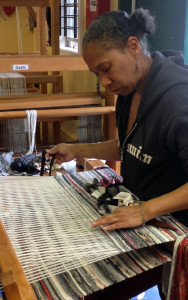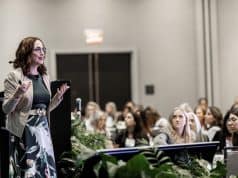
Five Goizueta Evening MBA students volunteered their time and management knowledge to help create a sustainable and refined business plan for nonprofit re:loom. The students, all with full-time jobs by day, did the work for free.
Re:loom is the third leg of Initiative for Affordable Housing (IAH), a nonprofit 501(c)(3) organization in Decatur, Ga. Employees weave hand-designed products, including rugs, table runners and hammocks, out of recycled materials and cloth.
Re:loom is, at heart, a social enterprise.
“We’re really trying to provide jobs for folks who have had extremely limited job skills,” said Lisa Wise, Director of re:loom. “They may never have had a job before, and re:loom is the place where you’re getting to practice [job skills] while getting paid to learn a new skill and practice [working].”
To be a sustainable venture, however, re:loom needed a defined business plan.
This is where the Goizueta MBAs entered the story.
[highlight]Susan Sunay 13EvMBA, a volunteer for the company, facilitated the relationship between Goizueta and re:loom in Fall 2014 when she saw an opportunity for the students and company to benefit[/highlight].
Evening classes were given a short description of re:loom from Goizueta’s program office. Josh Silcox, Nate Feather, Andy Cramer, Christopher Frederick and Jens Loebbermann found the time to step forward and volunteer their services.
“We wanted a new opportunity to apply the skills [we were learning in class],” said Silcox. “It seemed exciting, and, most importantly, it gave [us] an opportunity to take our management practice skillset and apply it in a completely new environment.”
The men approached the project from a marketing perspective by focusing on ways to bring money and clients to the company to boost sales.
[pullquote]It seemed exciting, and, most importantly, it gave [us] an opportunity to take our management practice skillset and apply it in a completely new environment.[/pullquote]
“We put a lot of work into it,” Loebbermann said. “There were so many things to do initially, so we had to focus very early on what the company really needed, and prioritize.”
The students created a matrix for re:loom that scored companies based on how well their ideals align. The higher the score, the better the fit. Therefore, re:loom could see an increased chance of a successful partnership.
“We also put some extra points in there,” Loebbermann explained. “For example, if you have a contact [at a company], the approach is always easier, and the match will likely work.”
Thanks to the students, Wise’s job is significantly easier. Now, she can simply look at the score of a company she is trying to approach and see how successful a partnership might be.
In the past, Wise had companies approach her trying to dump excess cloth on re:loom in order to get better tax returns, without trying to form a partnership. The MBAs helped fix this problem, too.
Students produced a paper and articulated the goals of re:loom while creating a strategic business plan for the company to approach other businesses, corporations and individuals.
“They gave an awful lot of time,” says Wise. “Their report is really excellent. They identified our priorities and spoke to the three really big issues of re:loom. It was a pretty defined business plan that spoke directly to our needs and our goals and it is extremely useful.”











